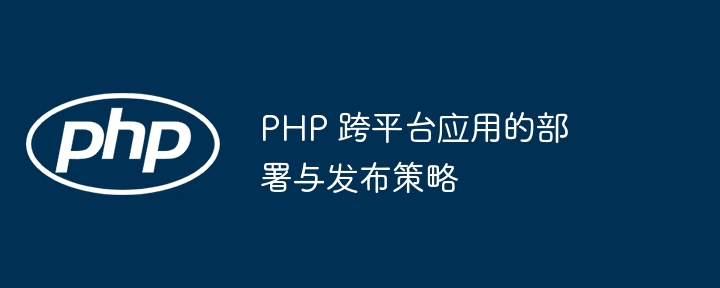Home >Backend Development >PHP Tutorial >Deployment and release strategy for PHP cross-platform applications
Deployment and release strategy for PHP cross-platform applications
- 王林Original
- 2024-05-07 08:12:021240browse
Deployment strategy: Microservice architecture: Independent deployment module Containerization: Use container technology to package applications Cloud deployment: Use cloud platform services to automate deployment Release strategy: Rolling update: Deploy new versions gradually Blue-green deployment: Run new and old versions simultaneously Switch the traffic characteristic flag: gradually introduce new functions for testing Practical cases: Deploying PHP applications using Docker

Deployment and release strategy for PHP cross-platform applications
In cross-platform application development, deployment and release strategies are crucial to ensure the stability and performance of the application on different platforms and environments. This article will explore the best practices for deploying and publishing PHP cross-platform applications and provide practical cases.
Deployment strategy
1. Microservice architecture:
Decompose the application into independent small modules, each Modules are responsible for specific functions, which allows independent deployment and version control.
2. Containerization:
Use containerization technology such as Docker to package the application into a portable package, including all dependencies and configurations.
3. Cloud deployment:
Use the deployment services of cloud platforms such as AWS, Azure or Google Cloud to provide automatic expansion, load balancing and disaster recovery functions.
Release strategy
1. Rolling update:
Deploy new versions to different servers gradually to maximize Reduce interruptions.
2. Blue-green deployment:
Run the old and new versions at the same time, and gradually switch traffic to the new version to discover problems and roll back.
3. Feature Flags:
Use feature flags to gradually introduce new features for A/B testing and gathering feedback.
Practical case: Deploy PHP application using Docker
The following code shows how to use Docker to deploy a simple PHP application:
// Dockerfile 文件
FROM php:7.4-apache
RUN apt-get update \
&& apt-get install -y libzip-dev
COPY . /var/www/html// 构建镜像 docker build -t my-php-app . // 运行容器 docker run -d -p 80:80 my-php-app
Through these strategies With the combination, you can effectively deploy and publish PHP cross-platform applications, ensuring their reliability, maintainability and scalability in different environments.
The above is the detailed content of Deployment and release strategy for PHP cross-platform applications. For more information, please follow other related articles on the PHP Chinese website!

